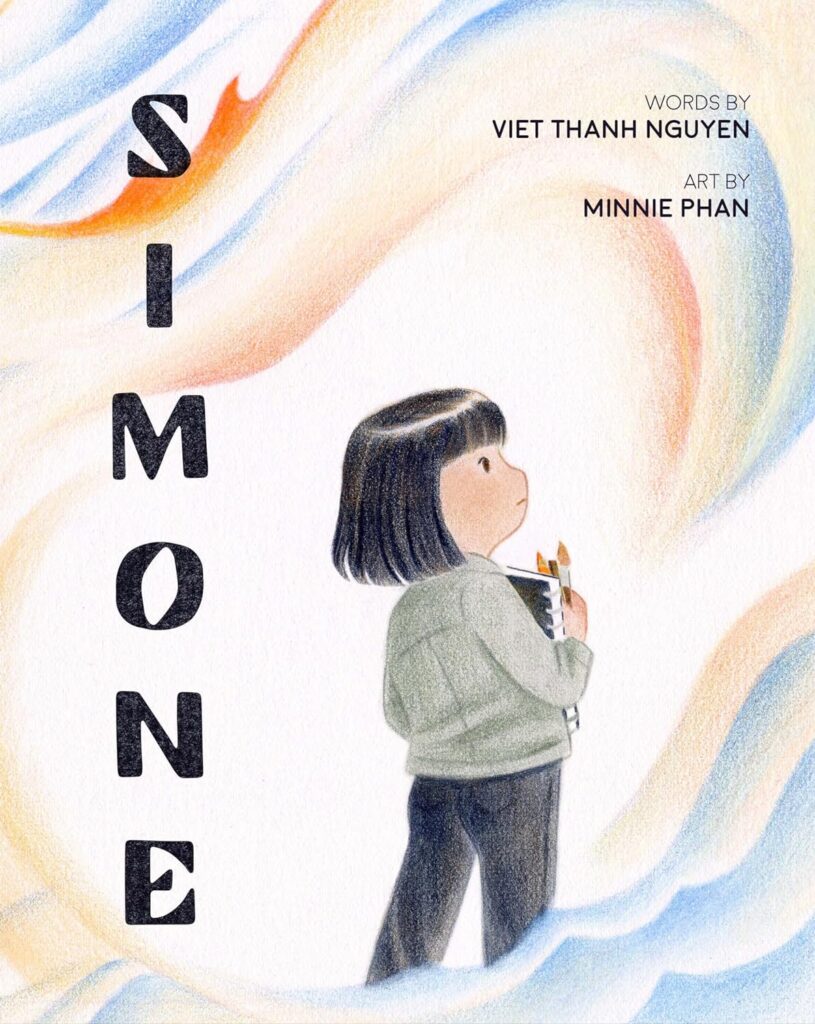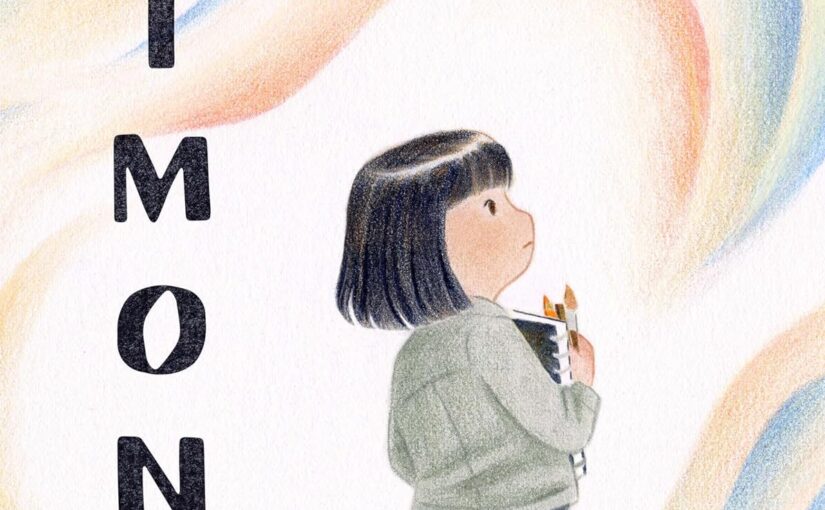Children almost certainly don’t think of books as a gateway to a different world or an opportunity to learn something in a second-hand, entertaining manner. Granted, those two takeaways are a major reason why people enjoy reading books, but to some young elementary ages books are more of a thing that you have to do, and doing things under duress is very rarely cool. Simone is not the first illustrated book that mid to upper-elementary students will look for. Its indistinct cover implies nothing about the book’s plot. All you see is an Asian girl with a sketchbook and paintbrushes, wistfully looking out as waves of colors bend ahead of her.

Simone opens with a dream sequence, with her peacefully taken out to sea. That two-page sequence abruptly goes into the publisher’s page and the book’s title. Then the book starts in earnest, with Simone being woken up from her dream by her mother because a fire is quickly approaching their house.
The subtle effect of the start/stop with that two-page introduction is very effective and draws you into the story, even though you don’t know what’s going on. In a way, it’s similar to the opening sequence from a James Bond movie. In the case of Simone, it’s not the action that brings you in, it’s the comforting soft colors and the fact that you want to see more of them. Thus, it’s even more jarring when Simone is shown in her bedroom there are very few colors, only black, white, and orange, all of which in different shades.
With the fire approaching, Simone’s mother tells her to only get her favorite things as quickly as possible. The streets are jammed with cars trying to leave the area and people attempting to gather their pets and get to their vehicles. They see people from the fire department and temporary firefighters from the CDCR scattering around the streets helping people and fighting fires. Her mother senses that Simone is scared, so she tells her the story of when she had to flee her childhood home in Vietnam.
For her, it was a massive flood, and just like Simone, she was only able to grab a couple of things before she left. Ma, as Simone calls her, grabs her crayons, which become a prominent symbol throughout the book. She explains how the flood didn’t kill anyone and Simone goes on about parlaying those experiences to what she’s going through now. At the high school gym, which’s now become the fire evacuation area, Simone leads the children in drawing firefighters. When the danger of the fire goes away, they’re able to go back home, where some people discover their house has been destroyed, while others are more fortunate. She then has a playdate at her house with one of the kids she met in the fire shelter.
As the book progresses, there are more and more colors, which builds upon itself as a climax. The illustrations, especially the landscape scenes, are beautiful and drawn in a way that makes elementary school readers feel like they’re in a graphic novel. A family displaced by a wildfire and a flood in the country that your mom grew up in is not the sort of stuff that you’d expect to be entertaining in an illustrated book, but Simone pulls it off, albeit on a surface aspect.
Some older readers who don’t have any experience with wildfires might get irked by the CDCR firefighter. CDCR stands for California Department of Corrections and Rehabilitation and they have “volunteer” firefighters join the ranks when things get dire. When Simone’s mother is explaining their role in firefighting she uses the word “maybe” to confirm the question as to if they did bad things. I would use the word “probably” or the phrase “almost certainly” if I were asked if someone in prison had done bad things. Nothing in life is 100%, but where there’s smoke there’s fire, to take inspiration from the book.
Secondly, when Simone is inspiring kids in the shelter to draw firefighters, one of the kids says that firefighters wear yellow. She takes offense to this and says that they can also wear orange, while a little girl behind her says that girls can be firefighters too. Suddenly all of the kids start listing various skin hues, like black, brown, and Asian*, and affirming that anyone can be a firefighter. I spend some time in elementary schools, the trope that only men, or only white men can do certain jobs does not play out. Kids today know that any kid has the capacity, given their strength or abilities to do any job that they’re capable of.
It’s worth noting that I shared Simone with our 14-year-old to see if he would catch the two things that irked me about the book. They didn’t agree with our take on the CDCR firefighter but did agree with me that every elementary school student has the fact that any kid can do anything drilled into their psyche so deep that it feels like a pier being moored during a thunderstorm in a full moon.
There will always be some jackwagon kid in elementary school who will glibly question, “I thought only men could be firefighters.” They’re doing this for attention and the more that students or authors play into these low-information people the more that they feed the pigeons. Don’t feed the pigeons.
Some adults will latch onto the low points in the book, but most kids will pay more attention to the art and major story arc. If kids open the book they’ll be attracted to the graphic novel presentation of it. Its simple vocabulary and art will also draw them in. However, the book’s curious, uninspiring cover doesn’t bait the hook in a way that lets the book achieve school-water cooler coverage. There’s something worth seeing in Simone, but it faces an uphill battle with a couple of unforced errors that are in its path.
Simone is by Viet Thanh Nguyen with art by Minnie Phan and is available on Minerva, an imprint of Astra Books for Young Readers.
*I know that ‘Asian’ is not a skin tone, but in the book, it lists them as two colors and a race, which kind of sounds like a drinking game.
There are affiliate links in this post.





 Facebook
Facebook Twitter
Twitter Flickr
Flickr GooglePlus
GooglePlus Youtube
Youtube